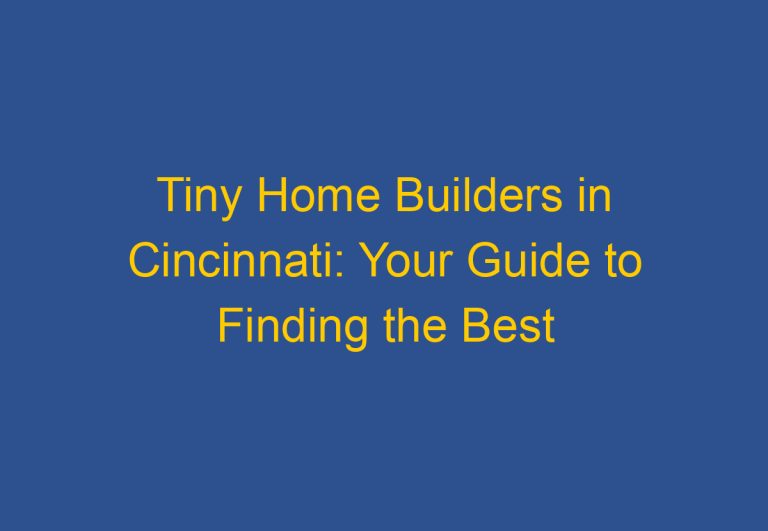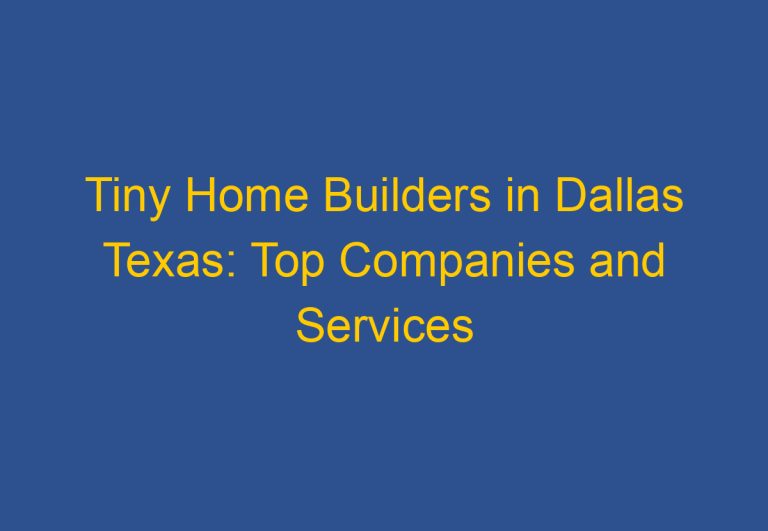Can You Build a Tiny Home on Your Property? A Guide to Zoning Laws and Building Codes
Tiny homes have become increasingly popular in recent years as people look for more affordable and sustainable housing options. One question that often arises is whether it is legal to build a tiny home on your own property. The answer to this question varies depending on a number of factors, including the location of your property and the local zoning laws.
In general, building a tiny home on your own property is legal as long as you meet certain requirements. For example, you may need to obtain a building permit and adhere to local building codes. Additionally, the size and placement of your tiny home may be restricted by zoning laws, which dictate how properties can be used in different areas. It is important to research these requirements before beginning construction to avoid any legal issues down the line.
Despite the potential challenges, building a tiny home on your own property can be a great way to create a more affordable and sustainable living space. With the right planning and preparation, it is possible to build a tiny home that meets your needs and complies with local laws and regulations.
Understanding Zoning and Legal Requirements
When it comes to building a tiny home on your property, it’s important to understand the zoning and legal requirements that apply in your area. This section will provide an overview of the different zoning and legal requirements that you need to be aware of before building a tiny home.
Navigating Local Zoning Ordinances
Zoning laws and regulations vary from state to state, county to county, and city to city. It’s important to research and understand the local zoning ordinances in your area before building a tiny home. Some areas may have specific zoning codes that allow for the construction of tiny homes, while others may not. In some cases, you may need to apply for a variance or special permit to build a tiny home on your property.
Building Codes and Tiny Homes
Like traditional residential homes, tiny homes are subject to building code requirements. While these codes will vary from state to state, there are some general things you should know about building codes for tiny homes. Tiny homes are expected to have certain safety features, such as smoke detectors, fire extinguishers, and proper ventilation. Additionally, tiny homes may need to meet certain energy efficiency standards.
Permits and Certifications for Tiny Homes
Before building a tiny home, you may need to obtain various permits and certifications. These may include building permits, electrical permits, plumbing permits, and more. Additionally, some areas may require that your tiny home be certified by a third-party organization to ensure that it meets certain safety and quality standards.
It’s important to research and understand the permits and certifications that are required in your area before building a tiny home. Failure to obtain the necessary permits and certifications can result in fines and legal issues down the road.
Planning and Construction of Tiny Homes
When building a tiny home on your property, there are several key factors that need to be taken into consideration. These include choosing the right location on your property, design and size considerations, and foundations and structures.
Choosing the Right Location on Your Property
When choosing the location for your tiny home, it is important to consider factors such as zoning regulations, access to utilities, and the overall aesthetic of your property. You will need to ensure that your tiny home complies with local zoning regulations and that you have access to water, electricity, and sewage systems.
Design and Size Considerations
Design and size considerations are important when building a tiny home. You will need to decide on the type of foundation you want to use, as well as the overall structure of your tiny home. There are several different types of foundations to choose from, including slab, crawl space, and pier and beam. You will also need to consider the minimum square footage and floor area requirements for your tiny home.
Foundations and Structures
The construction process of a tiny home can vary depending on the type of foundation and structure you choose. It is important to hire a professional contractor who has experience building tiny homes to ensure that your home is built to code and is structurally sound.
Overall, building a tiny home on your property can be a great way to downsize and live a more sustainable lifestyle. With careful planning and consideration, you can create a beautiful and functional space that meets your needs and fits within your budget.
Types of Tiny Homes and Legal Implications
Tiny Homes on Wheels vs. Stationary Tiny Homes
When it comes to building tiny homes, there are two main types: those built on wheels and those built on a foundation. Tiny homes on wheels are often classified as recreational vehicles (RVs) and must be registered with the state’s motor vehicle department. On the other hand, stationary tiny homes are built on a foundation and are subject to building codes and zoning regulations.
For those interested in building a tiny home on their property, it is important to understand the legal implications of each type. Building a tiny home on wheels may be easier in terms of zoning and building codes, as they are often classified as RVs. However, there may be restrictions on where they can be parked or lived in full-time. Stationary tiny homes may require permits and inspections to ensure they meet the International Residential Code (IRC) and Appendix Q standards for tiny homes.
Accessory Dwelling Units (ADUs) and Regulations
Another option for building a tiny home on one’s property is through the construction of an Accessory Dwelling Unit (ADU). ADUs are typically small, secondary dwellings built on the same lot as a primary residence. They can be used as rental units, guest houses, or even as a primary residence.
However, regulations for ADUs vary by state and local government. Some areas may require a permit for construction, while others may have restrictions on size and occupancy. It is important to research and understand the regulations in one’s area before building an ADU or any type of tiny home.
In conclusion, building a tiny home on one’s property can be a viable option for those looking to downsize or live a simpler lifestyle. However, it is important to understand the legal implications and regulations surrounding each type of tiny home, whether it be a tiny home on wheels or a stationary tiny home, or through the construction of an ADU.
Financial and Practical Considerations
When considering building a tiny home on one’s property, there are several financial and practical considerations that must be taken into account. Here are some of the most important considerations:
Estimating the Cost of a Tiny Home
The cost of building a tiny home can vary widely depending on several factors, including the size of the home, the materials used, and the location of the build. On average, a tiny home can cost anywhere from $10,000 to $100,000 or more. It is important to keep in mind that building a tiny home can often be more expensive per square foot than building a traditional home due to the unique design and construction requirements.
Financing and Loans for Tiny Homes
Financing a tiny home can be challenging, as many traditional lenders do not offer mortgages for tiny homes. However, there are other financing options available, including personal loans, home equity loans, and RV loans. It is important to research all of these options thoroughly and compare rates and terms before making a decision.
Impact on Property Value and Insurance
Building a tiny home on one’s property can have an impact on property value and insurance. While a well-designed and well-built tiny home can add value to a property, it is important to keep in mind that not all appraisers or lenders may see it that way. Additionally, insurance for a tiny home can be more difficult to obtain and may be more expensive than insurance for a traditional home.
Overall, building a tiny home on one’s property can be a great way to downsize and simplify one’s life. However, it is important to carefully consider all of the financial and practical aspects of such a project before getting started.
Frequently Asked Questions
What permits are required to build a tiny house on my property?
If you plan to build a tiny house on your property in Ohio, you will need to obtain the necessary permits before starting construction. The specific permits required will depend on the location of your property and the local building codes. It is recommended that you contact your local zoning board or building department to determine the specific requirements for your area.
Are there specific laws in Ohio governing tiny house construction?
Ohio does not have specific laws governing the construction of tiny houses. However, tiny houses are subject to the same building codes and zoning regulations as traditional homes. It is important to ensure that your tiny house meets all the necessary building codes and zoning requirements before you start construction.
Is it possible to join a tiny house community in Ohio?
Yes, there are several tiny house communities in Ohio that allow residents to park their tiny homes on the property. These communities often offer shared amenities and a sense of community for those interested in the tiny house lifestyle. It is important to research and visit different communities to find the one that best fits your needs and preferences.
What are the regulations for parking a tiny house in Ohio?
The regulations for parking a tiny house in Ohio will depend on the location of your property and the local zoning laws. In general, tiny houses are considered to be recreational vehicles and may be subject to specific parking regulations. It is important to research the specific regulations in your area before parking your tiny house on your property.
Can I legally construct my own tiny house in Ohio?
Yes, it is legal to construct your own tiny house in Ohio as long as it meets all the necessary building codes and zoning regulations. It is important to research and understand the specific requirements for your area before starting construction.
Are there affordable pre-built tiny homes available for purchase?
Yes, there are several companies that offer pre-built tiny homes for purchase in Ohio. These homes range in price depending on the size and features, but many are designed to be affordable for those interested in the tiny house lifestyle. It is important to research different companies and models to find the one that best fits your needs and budget.












